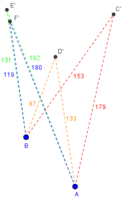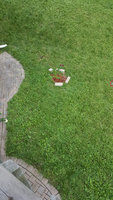Michelle N
New member
- Joined
- Oct 31, 2019
- Messages
- 7
Hi,
I'm really hoping someone can help me. I've been trying to make a plan of an area of my yard so I can use it to make a design for a new garden. I decided that the easiest way to convert for scale is to measure in inches and draw in the equivalent number of millimeters on my software (i.e. 1mm = 1 inch). I have a border on one side that is an existing patio and three existing shrubs plus an electrical outlet. What I did was take one straight edge of the patio and measured it as the base of a triangle (|AB = 70 inches). I then measured (using a laser, so accurate enough for my purposes) from point A to the centre of each shrub and also the outlet, and did the same from point B to each. I thought that all I would have to do would be to use each measurement as a radius of a circle with centre points at A and B and where they intersected would be the position of the shrub/outlet in question. (So for example |AC was 14 feet, 11 inches, |BC 12 feet, 9 inches; my drawn circle centred on A was 358mm in diameter, my circle centred on B had a diameter of 306mm). However, this resulted in a picture where instead of shrubs E and F being next to each other as in real life and in the rough sketch below, they ended up almost on top of each other. I must be doing something wrong but I don't know if it's my measurement, my arithmetic, my scaling, or my geometry.
My measurements were as follows:
|AB = 5' 10"
|AC = 14' 11"
|BC = 12' 9"
|AD = 11' 1"
|BD = 7' 3"
|AE = 16'
|BE = 10' 11"
|AF = 15'
|BF = 9' 11"

I'm really hoping someone can help me. I've been trying to make a plan of an area of my yard so I can use it to make a design for a new garden. I decided that the easiest way to convert for scale is to measure in inches and draw in the equivalent number of millimeters on my software (i.e. 1mm = 1 inch). I have a border on one side that is an existing patio and three existing shrubs plus an electrical outlet. What I did was take one straight edge of the patio and measured it as the base of a triangle (|AB = 70 inches). I then measured (using a laser, so accurate enough for my purposes) from point A to the centre of each shrub and also the outlet, and did the same from point B to each. I thought that all I would have to do would be to use each measurement as a radius of a circle with centre points at A and B and where they intersected would be the position of the shrub/outlet in question. (So for example |AC was 14 feet, 11 inches, |BC 12 feet, 9 inches; my drawn circle centred on A was 358mm in diameter, my circle centred on B had a diameter of 306mm). However, this resulted in a picture where instead of shrubs E and F being next to each other as in real life and in the rough sketch below, they ended up almost on top of each other. I must be doing something wrong but I don't know if it's my measurement, my arithmetic, my scaling, or my geometry.
My measurements were as follows:
|AB = 5' 10"
|AC = 14' 11"
|BC = 12' 9"
|AD = 11' 1"
|BD = 7' 3"
|AE = 16'
|BE = 10' 11"
|AF = 15'
|BF = 9' 11"







